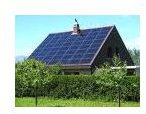Evergreen ES Solar Panels
Solar Panels and their Types
A solar panel or photovoltaic (PV) module is a set of silicon cells designed to convert solar energy into electrical power. There are many types of solar panels. Monocrystal and polycrystal panels use crystalline silicon and seem to be the most efficient. Other types include the amorphous or thin film silicon panels that seem to be less efficient but cheaper, and finally the vaporware panels that use plastic spray on top of the solar panel.
The Performance of Evergreen Panels Until Now
Evergreen Solar, Inc. is an established manufacturer of solar panels. They use a patented wafer manufacturing technology to produce polycrystalline silicon panels and they are well-known in the market for their high efficiency and performance displaying products. The manufacturing of polycrystalline solar panels can be made using two main methods: cast polysilicon and string ribbon silicon.
The ES A panel series of Evergreen that became commercially successful since their launching in 2008 rely on the string ribbon production method. In this process, silicon is melted and cast into a large block. After it has cooled down, thin strips of silicon are drawn out of the block and then assembled on top of a panel structure with metal conducting strips for the electrical current to flow. This method can produce polycrystalline solar panels with the highest efficiency available and it seems to be the cheapest one since the expensive sawing process can now be eliminated.
According to a 2008 review by the Dailygreen.com, Evergreen is among the top three solar panel manufacturers - the others being Kyocera and Sanyo. During a comparison among 190-watt solar panels, Sanyo panels were more efficient (17.4 %) than the Evergreen panels due to a patented thin layer technology used in construction. The Kyocera panels were the most cost-effective due to the company’s policy for long-term warranty. The major advantage of Evergreen panels seemed to be their fast energy payback, i.e. the time it takes for the energy consumed during the manufacturing process to be offset by the energy generated by the solar panel.
The ES-D and ES-E Panels of Evergreen and the New BOOST Cell Technology

Evergreen has recently announced (Intersolar 2010) the production of a new series of solar panels, the ES-D and ES-E. The ES-D panels are designed for residential use following two sets of specifications for roof installations: optimized performance and optimized aesthetics. The ES-E panels are more suitable for commercial applications where the demands for technical design and efficiency are even higher.
According to the company, these new panels are designed with the newly developed BOOST Cell Technology that can offer higher efficiencies, better aesthetics, and, of course, less impact on the environment. The new technology entails the use of silicon micro wires instead of conventional silicon strips or bus-bars to optimize the solar energy collection and reduce cell shading. The details of the new technology are not revealed but the use of micro and nanotechnology has been proven to improve device performance, so this may actually be a promising venture.
Are ES-D and ES-E the Best in Class?
The ES-D and ES-E series solar panels are not commercially available yet (released ending of 2010). The company does not reveal the efficiency achieved so far, however this is a common marketing policy among competitors. Certain acclaimed features including the fast energy payback (less than 12 months) and the small carbon footprint, have been confirmed by reviews for their previous series, so a similar and even better performance is expected for their new products.
Therefore, an accurate assessment of the new ES-D and ES-E panels can only be made after they have been tested and compared to other commercially available products on features regarding price, efficiency, energy payback, environmental impact, and overall performance.
Sources:
- Evergreen Solar, Inc.
- Northern Arizona Wind & Sun
- The Daily Green: Home Solar Panels Reviewed
- ES-A Series: DC Power Systems
